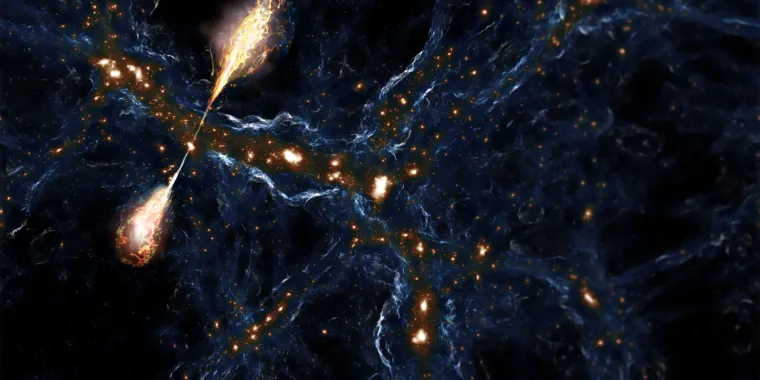
Groundbreaking Discovery: Scientists Uncover the Largest Black Hole Jets in Cosmic History!
2024-09-18
In a stunning revelation, astronomers have detected the largest jets ever emitted by supermassive black holes, shattering previous records and expanding our understanding of these cosmic giants. These black holes, which lie at the heart of galaxies, play a pivotal role in their environment, influencing star formation and regulating the galactic ecosystem through the intense radiation they emit when they consume nearby gas and dust.
But the impact of these supermassive black holes stretches far beyond the confines of their respective galaxies. Recent research reveals that some black holes possess jets capable of ejecting material across staggering distances, potentially communicating with other galaxies and intertwining within the vast cosmic web made up of dark matter.
A New Frontier in Cosmic Exploration
This groundbreaking study, led by a team of dedicated researchers utilizing the LOFAR (Low-Frequency Array) radio telescope, has revealed jets spanning an astonishing 23 million light-years—equivalent to about seven megaparsecs. This remarkable distance indicates that these jets are not just powerful; they are capable of sending matter into adjacent galaxies and contributing to the greater structure of the Universe.
Jets originating from black holes are formed from the chaotic and energetic environment surrounding them. As material spirals in toward a black hole, it becomes heated to extreme temperatures, which ionizes it and generates strong electromagnetic fields, essentially turning these regions into natural particle accelerators. As a result, jets composed of particles are expelled at incredible speeds, often approaching that of light itself.
Typically, these black holes produce jets from both of their poles, creating two opposing outflows that have been documented across various scales—from smaller stellar-mass black holes to the supermassive varieties that give rise to quasars, the brightest entities in the universe.
A Search Like No Other
The groundbreaking finding resulted from an organized effort to locate these enormous jets within the radio frequencies captured by the LOFAR telescope. The vast data set was not only analyzed using sophisticated machine learning techniques, but it also relied on the dedication of citizen scientists volunteering their time and expertise. This initiative has already identified over 11,000 jets spanning megaparsec distances, with the newly identified giant jet officially named "Porphyrion," after a titan from Greek mythology.
To confirm the origin of this colossal jet, researchers pored over images of galaxies within the vicinity of Porphyrion. Their investigation led them to a galaxy approximately ten times the mass of our own Milky Way, dating back around 6 billion years after the Big Bang—essentially offering a window into a past era of our cosmos.
This extraordinary discovery not only challenges what we know about the dynamics of galaxies and black holes but also opens new avenues of inquiry into the role these jets play in the large-scale structure of the universe. As researchers continue to study these immense cosmic phenomena, we may be on the brink of revelations that could redefine our understanding of astrophysics and the very fabric of space-time as we know it. Stay tuned for more astonishing updates from the final frontier!




 Brasil (PT)
Brasil (PT)
 Canada (EN)
Canada (EN)
 Chile (ES)
Chile (ES)
 España (ES)
España (ES)
 France (FR)
France (FR)
 Hong Kong (EN)
Hong Kong (EN)
 Italia (IT)
Italia (IT)
 日本 (JA)
日本 (JA)
 Magyarország (HU)
Magyarország (HU)
 Norge (NO)
Norge (NO)
 Polska (PL)
Polska (PL)
 Schweiz (DE)
Schweiz (DE)
 Singapore (EN)
Singapore (EN)
 Sverige (SV)
Sverige (SV)
 Suomi (FI)
Suomi (FI)
 Türkiye (TR)
Türkiye (TR)